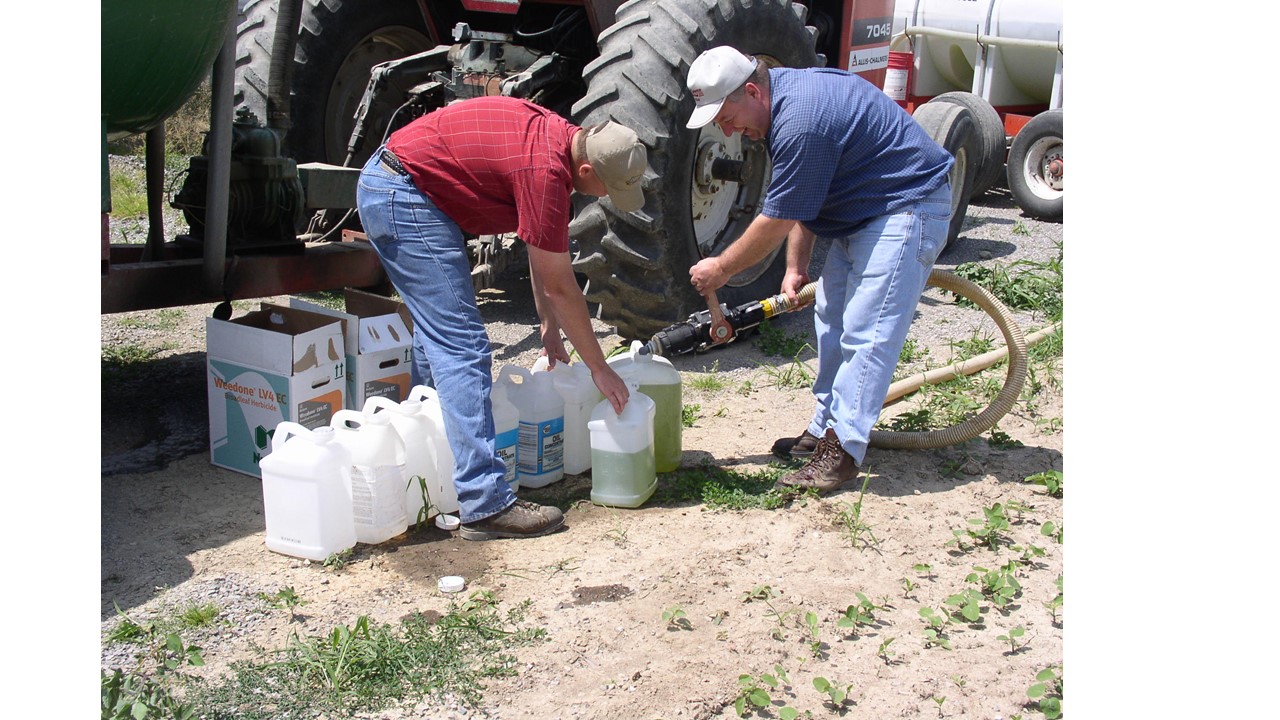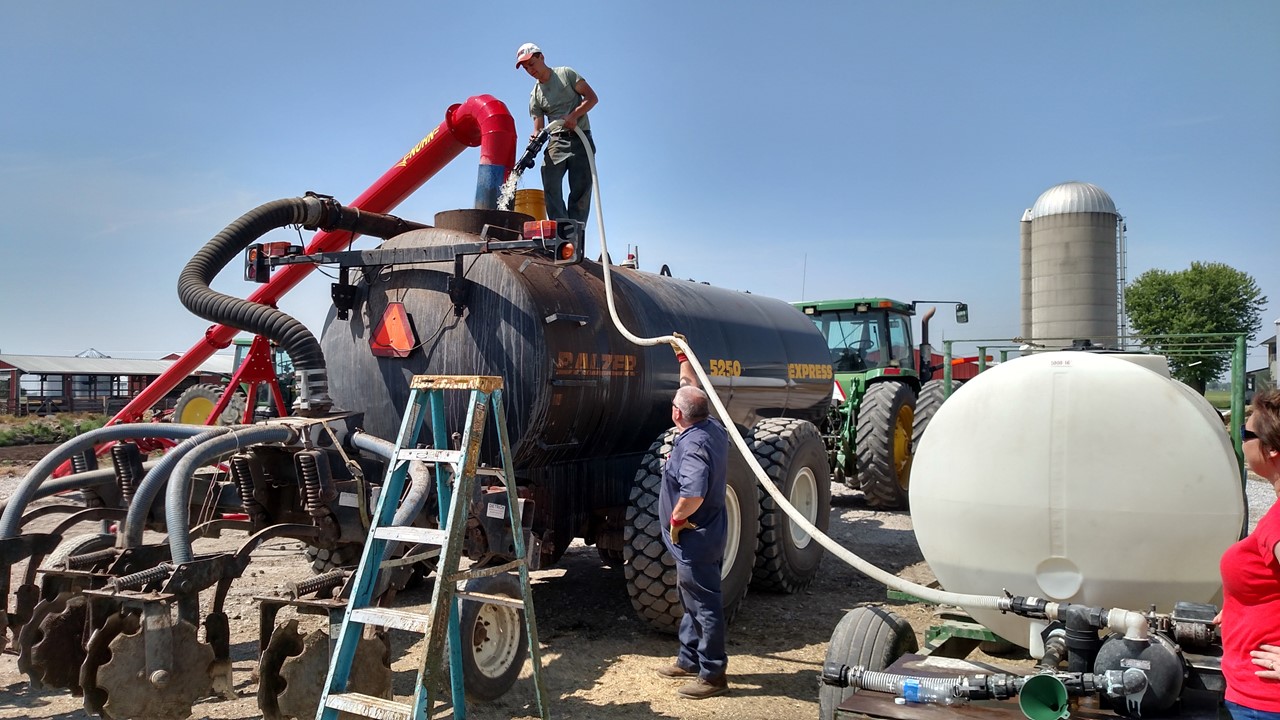Journal of the NACAA
ISSN 2158-9429
Volume 13, Issue 2 - December, 2020
Prescription Manure: Adding Nitrogen to Increase Liquid Manure Nutrient Content
- Arnold, G. , Field Specislist, Ohio State University Extension
ABSTRACT
Liquid swine nursery manure and liquid dairy manure are much lower in nitrogen content compared to liquid swine finishing manure. While swine finishing manure as a side-dress nitrogen source for corn is gaining popularity in the Midwestern states, the lower nitrogen content of swine nursery manure and dairy manure keeps these manure sources from being considered as a side-dress nitrogen source in corn fields. In this three-year replicated study, 28% Urea Ammonium Nitrate (UAN) was added to swine nursery manure, just prior to application, to boost the nitrogen content of the manure as a side-dress nitrogen source for corn. The manure, supplemented with 28% UAN, was land applied using a 5,250 gallon manure tanker with Dietrich incorporation sweeps. This treatment was compared to a 28% UAN treatment, applied without manure, but at a similar total nitrogen amount per acre. Yield results were similar between the two treatments each year of the study.
Introduction
Liquid swine finishing manure has been utilized in Ohio for many years as a side-dress nitrogen source for corn utilizing a manure tanker (Arnold et al., 2017) and a drag hose system (Arnold et al., 2018). In a corn-soybean rotation, the manure applied to the corn crop not only supplies the needed side-dress nitrogen but can also supply the correct amount of phosphorus and potash needed for the 2-year crop rotation. A study in the Canadian Journal of Soil Science (Schoenau & Davis 2006) noted that challenges in using animal manures as fertilizers include low nutrient content per unit weight, variability and availability of nutrient content, and a balance of available nutrients that often does not meet the relative nutrient requirements of the crop. Could liquid manure sources that are lower in nitrogen, such as swine nursery or dairy, be amended with commercial nitrogen and thus be better suited as side-dress fertilizer sources for corn?
In this study, 28% Urea Ammonium Nitrate (UAN) was added to swine nursery manure in the manure tanker, just prior to application, as a side-dress nitrogen source for corn. The addition of the 28% UAN was to increase the nitrogen content of the nursery manure so enough nitrogen was applied to meet the planned side-dress needs of the corn crop. The manure and 28% UAN mixture was subsurface applied using a 5,250-gallon manure tanker and Dietrich incorporation sweeps at a depth of five inches. This treatment was compared to a treatment of 28% UAN applied without manure but at similar total nitrogen amounts per acre. The 28%UAN applied without manure was incorporated using standard side-dressing equipment.
Dairy farms and swine nursery buildings in Ohio produce more than a billion gallons of manure annually. If these manure sources could have their nitrogen content increased, by the addition of commercial liquid fertilizer, they could be suited to utilize as side-dress nitrogen sources for corn. This could open a window of in-season manure application currently being used by owners of swine finishing barns.
Methods
In this three-year study two fertility treatments were arranged each year in a randomized complete block design with four replications. In each of the three years liquid swine nursery manure was enhanced with 28% UAN and sub-surface applied to corn fields at the V3 stage. All manure applications were made with a 5,250-gallon manure tanker with a Dietrich toolbar with covering wheels and injected to a depth of five inches. The 28%UAN treatments were applied using a standard applicator that injected the fertilizer to a depth of three inches. The plots were replicated four times each year and all treatments received 150 pounds per acre of nitrogen as side-dress each year. The plots also receive 10 gallons of 28% UAN as row starter so the final nitrogen amount was 180 pounds per acre. All treatments were applied the same day each of the three years.
The nursery manure application rate was 6,000 gallons per acre. The nursery manure contained 12.5 pounds of available nitrogen per 1,000 gallons and thus, contributed 75 pounds of nitrogen per acre for side-dress purposes. The remaining 75 pounds needed was accomplished by adding 25 gallons of 28% UAN to each tanker load of manure during the manure loading process. The first two years this was accomplished by filling five-gallon jugs (Figure 1) with the 28% UAN and pouring them in during the manure top-loading process. In the 3rd year of the study the 28% UAN transfer pump was timed to fill the five-gallon jugs. The transfer hose was then placed next to the top loader while manure was being loaded and operated for the period of time needed to unload 25 gallons (Figure 2). The turbulence during the loading process appeared to mix the two ingredients. This mixture seemed to stay properly mixed through the manure application process based on manure samples collected the first year.
Figure 1. 28% UAN being loaded into containers for adding to the manure tanker

Figure 2. Loading 28% UAN into the manure tanker using a hose
Treatment blocks were 1,200 feet in length and 30 feet (12 rows) in width. These were on-farm plots. The outer corn rows of the field were avoided to negate any edge-of-field factors. All 12 rows of each replicated treatment were harvested for yield and a weigh wagon was used to determine weights. A portable moisture tester was used to determine corn moisture for each replication and corn yields were adjusted to a dry-corn (15.0% moisture) basis.
The soil type was Genesee flood plain. The soil phosphorus level (Bray P1) was 34ppm and the potash level was 161ppm. The plots were conventional tillage in a corn-soybean rotation. These were non-irrigated fields and there was no sub-surface drainage field tile.
Results
Table 1 shows the corn yield results. All 12 rows of each treatment plot were harvested and counted towards the yield. There was no significant difference between the 28%UAN treatments compared to the nursery manure plus 28%UAN treatments in any of the three years.
Corn stands were evaluated for damage from the treatment applications. There was no observable stand loss during the manure or 28% UAN applications except on the end rows that were not part of the study. The weight of the manure tanker caused more damage on the end rows than the 28%UAN applicator. At harvest time, manure treatments had a slightly higher moisture percentage (approximately 0.5 %) than the commercial fertilizer treatments. This occurred each year. All yields were adjusted to 15.0% moisture.
Table 1. Corn Yield Results in Bushels per Acre. Subscript letters a and b indicate yields that year were statistically different using ANOVA at 0.10 probability level.
|
Treatments |
2012 |
2013 |
2014 |
3-year ave. |
|
1) Incorporated 28%UAN |
182.1 |
194.1 |
170.9 |
182.4a |
|
2) Incorporated swine manure with the 28% UAN added |
186.6 |
193.2 |
172.4 |
184.0a |
|
LSD (0.10) |
10.31 |
17.17 |
12.41 |
|
|
CV |
7.23 |
11.32 |
9.89 |
The nutrient analysis of the swine nursery manure and the swine nursery manure plus 28% UAN are shown in Table 2. These are the average of three samples collected during the 1st year of the study. A nursery manure sample was collected during the manure loading process during years two and three of the study and the analysis results were similar to the numbers from the first year.
The available nitrogen, which is the ammonia portion of the manure nitrogen plus approximately one-third of the organic nitrogen portion, is the nitrogen expected to be available to the corn crop. This number increased from 12.5 pounds per 1,000 gallons to 25.2 pounds per 1,000 gallons with the addition of the 28%UAN.
Table 2. Manure Nutrient Analysis (pounds per 1,000 gallons).
|
Composite of four samples collected at loading and application time |
||
|
|
Swine Nursery Manure |
Swine Nursery Manure and 28% UAN |
|
When collected: |
Top-filling manure tanker |
During the manure application process |
|
Total Nitrogen |
13.2 |
26.0 |
|
Ammonium Nitrogen (NH3) |
12.1 |
24.8 |
|
Organic Nitrogen |
1.1 |
1.2 |
|
Available Nitrogen |
12.5 |
25.2 |
|
Phosphorus (P2O5) |
6.1 |
6.3 |
|
Potash (K2O) |
15.1 |
14.8 |
Discussion
The manure analysis indicated the addition of the 28% UAN resulted in the increased nitrogen amount that was sought. The weight of a gallon of 28% UAN is approximately 10.2 pounds and the weight of a gallon of liquid nursery manure is approximately 8.4 pounds. These would be expected to separate if the mixture were not adequately agitated with the 28% UAN coming out of the manure tanker first as the manure tanker emptied from the bottom.
The slightly higher moisture for the manure treatments at harvest time could be due to the manure portion of the nitrogen being available further into the growing season. Farmers concerned about this moisture increase could switch to a corn hybrid with a slightly shorter season.
This method of adding 28% UAN to swine nursery manure could also be tried with other manures, such as dairy lagoon manure, that are traditionally low in nitrogen content. The method used in this study could work for anyone using a top-loading manure tanker. For livestock producers using a drag hose, 28% UAN could be added to a mixing tank near the manure pond or even injected into the manure hose at some point in the delivery system.
The nitrogen cost for the 28% UAN treatments was roughly $75 per acre. The liquid manure application cost, using the Minnesota Manure Distribution Cost Analyzer spreadsheet, was calculated at $20 per 1,000 gallons or $.02 per gallon. The cost of applying 6,000 gallons of swine finishing manure per acre as side-dress nitrogen was $120 per acre. In addition, the liquid swine manure applied at each site contained approximately $17.00 of P2O5 per acre and $19.00 of K2O per acre along with organic matter and a broad range of micronutrients.
Conclusion
In this study, liquid swine nursery manure with 28% UAN added provided similar corn yields to 28% UAN alone. The 28% UAN appeared to stay in suspension with the swine nursery manure. Adding the 28% UAN to the nursery manure just minutes before application probably eliminated issues that might have developed if the mixture had hours or days to undergo chemical reactions that could have resulted in some of the 28% UAN nitrogen becoming less available.
Applying liquid livestock manure to growing crops can potentially reduce manure nutrient losses, especially nitrogen, and give livestock producers another window of time to apply manure in-season to farm fields.
Literature Cited
Arnold, G.; Custer, S.; Noggle, S.; Richer, E.; Stachler, J. (2017) On-Farm Plot Results from Side-dressing Corn with Liquid Livestock Manure Using a Tanker. Journal of NACAA 10(2).
Arnold, G. ; Custer, S.; Richer, E. (2018) Side-dressing Emerged Corn with Liquid Swine Manure Using a Drag Hose. Journal of NACAA, 11(2).
Schoenau J., Davis, J., Optimizing Soil and Plant Responses to Land-Applied Manure Nutrients in the Great Plains of North America. Canadian Journal of Soil Science. (2006)

